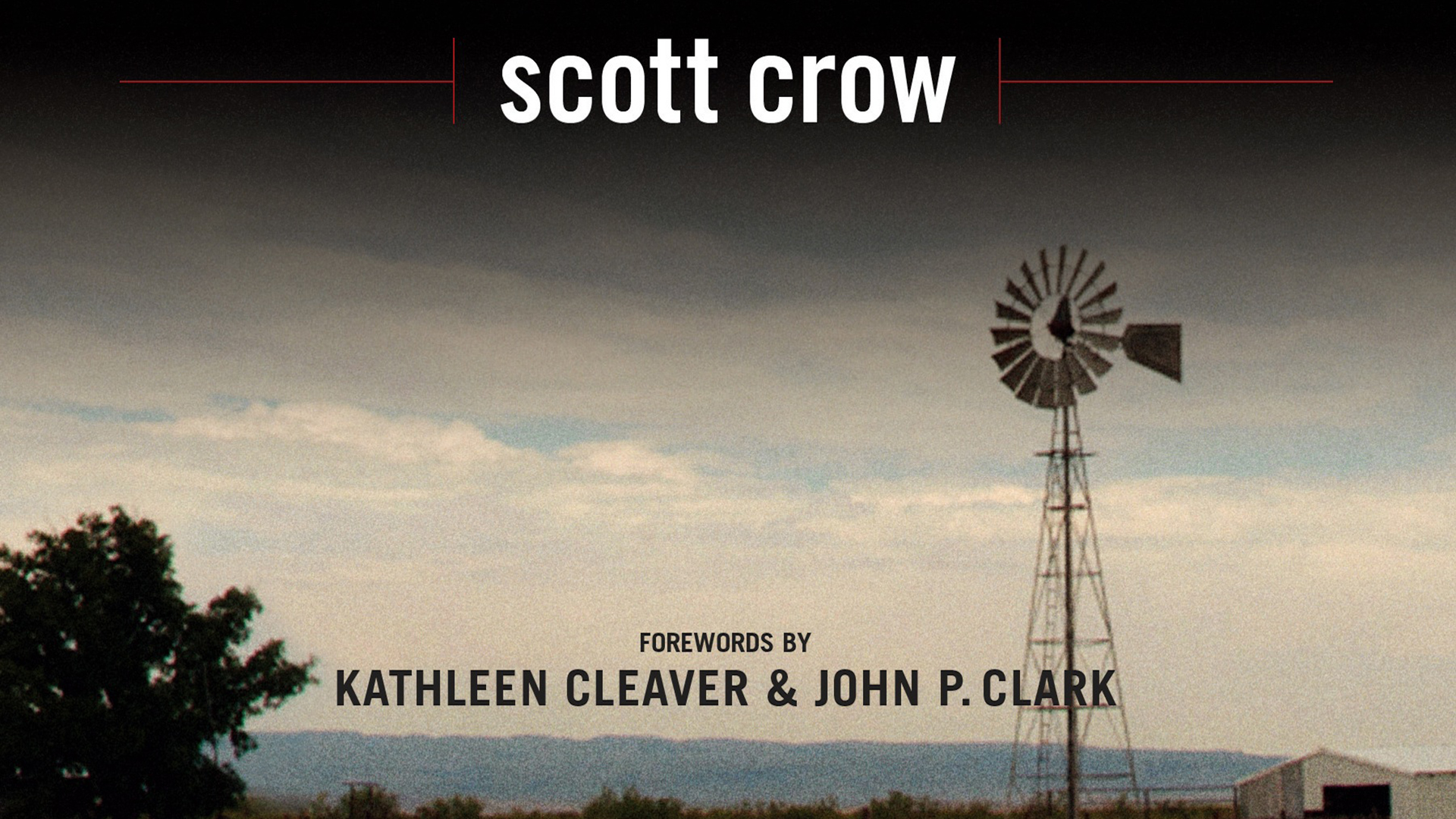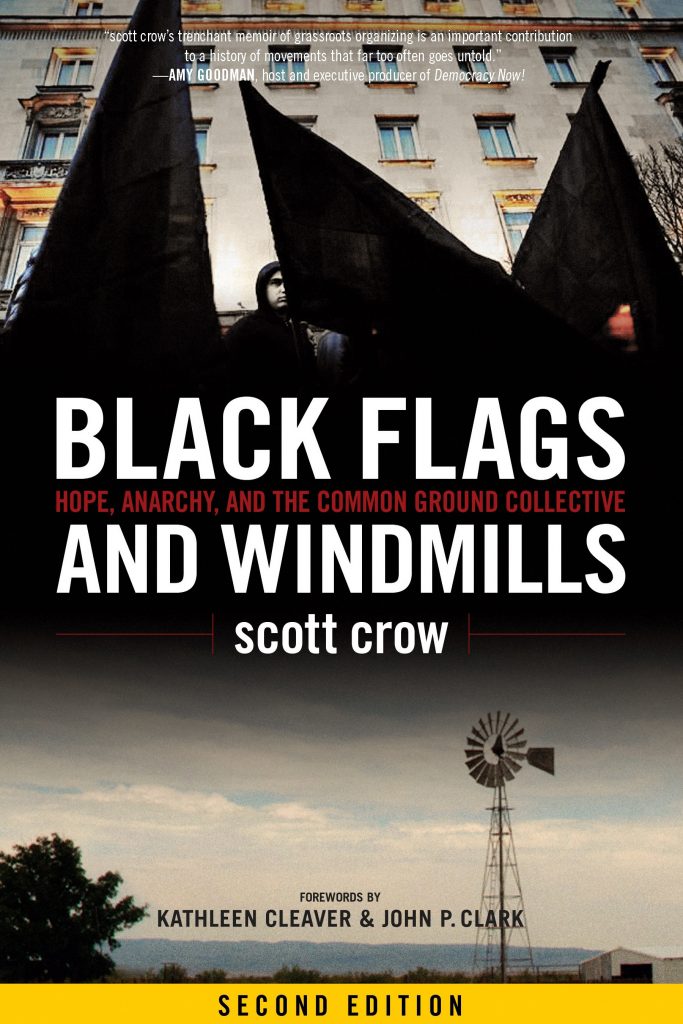by Sasha
Earth First! Newswire
November 1st, 2012
Hope, Anarchy, and the Common Ground Collective: An Epic Tale Past the Point of No-Return
When I began reading Black Flags and Windmills (PM Press 2011), by scott crow, my imagination was sparked by the power of scott crow’s commitment to radical organizing. There is a sense of no return that pervades this deep and intense work. In passionate and effusive prose, crow describes the nature of Hurricane Katrina’s impact as well as organizing efforts to support communities of color and poor people in the Algiers neighborhood. But crow lends an equal amount of time to exploring the logistical aspects of organizing, and how they relate to an unshakable faith in anarchism. For the fascinating and courageous insight into strong, though radical in its self-critique, anarchist praxis, Black Flags and Windmills has become a classic in the genre of non-fiction, and an important tool for folks today working in the context of rising cats-tastrophy (hint, hint, Hurricane Sandy…).
Catastrophe organizing is a growing scene these days. When it started, it seemed like it was only quiet-type crusty punks with nuck-tats in carhartt overalls whose wobbly walk evinced that straight-off-a-freight-train disorientation. Today, however, the acknowledgment of catastrophe, and the need to create infrastructure to produce popular networks of resistance to authority, are coming together in a big way. Much of this has been prefigured by crow’s work, along with the radicals who started up the Common Ground Collective as a response to Hurricane Katrina in 2005. Crow lays out in Black Masks and Windmills the blueprints for the structuring of Common Ground, how it emerged by spontaneous organizing, through painstaking efforts, extensive meetings, and open conflicts with law enforcement and white militias.
But in this sense, prefigurative politics takes on two meanings. crow makes it clear that the Common Ground idea was not new: it derived from the praxis of Black Liberation (the Black Panthers in particular), the Spanish Anarchists of 1936, and the Zapatista uprising of 1994. crow even makes a few references to his experiences organizing the late-1990s project, Dirty South Earth First!, which landed him on the eco-terrorist watch list, and might have helped inform his ideas on free states and land occupations. The facts remain: not only was crow helping to build a popular anarchist infrastructure that would present a model for future catastrophe organizers, but the folks at Common Ground were also using Common Ground as a prefiguration of revolutionary, land-based organizing. By covering a territory and ensuring the needs of the peoples who lived there, Common Ground was able to provide the instrumental care for those whom the state had abandoned. In this sense, Common Ground’s reason for existence was powerfully just, and the excellence with which the collective carried out its mission indicates that its influence will continue on to the next generation, who will need it most of all.
crow quotes Che Guevara in saying that “Hope is the conviction that struggling makes sense.” Throughout the book, crow draws on his comrades Malik Rahim and Robert Hillary King as well as myriad post-colonial, leftist, activist, and anarchist sources, pulling his own life’s narrative over the loom of radical scholarship to weave a subjective analysis that is always reaching out, asking for advise, drawing the reader in. This engagement with the reader is a reflection of crow’s civic engagement as well as his analysis of power. The difference, for crow, between Power and power is the manner with which it is instated. There is Power of domination and exploitation, and there is power in popular organization, consent, community, and free expression. This is the power of the people, the justice of the right to survive.
Today, crow is touring the country, discussing state repression and anarchist organizing. He talks often about what he calls “the emergency heart” of radical organizing. Under the constant pressures of the state, political, and economic oppression, organizers can feel completely hemmed in by the jobs, the financial constraints placed on their families, and the policial-social realities of racism, sexism, homophobia, and so on. We constantly feel like we’re in an emergency situation placed on us by such terrible pressures. The emergency heart pounds through these dead-end feelings of hysteria, and leaps into action. This profound gesture of awareness and love breeds hope and optimism in the community. It opens the time and space to act, beyond the stifling anxieties that lead people toward blame, resentment, and hate. Thus, it forms community. And community is what we need to get along.
When we read Black Flags and Windmills, we get a sense of heroic narrative—the tradition of black liberation, third world revolution, anarchist organizing—but we can understand this only in the context of a politics of friendship, a constant feeling of giving and understanding. For the heroism of this text does not belong to crow, it belongs to the reader, to the people of the lower 9th Ward, to the volunteers who showed up to lend a hand or a few dollars to the effort. The heroism of this text belongs to the suffering peoples of the East Coast who have suffered the deluge of climate change, and are organizing rhizomes of direct action, some of them under the auspices of the Occupy movement.
Hence, the Occupy movement’s natural gesture toward catastrophe organizing has only come out through necessity and hope, as described by crow in Black Flags and Windmills. This book is definitely recommended to anyone thinking about organizing and having an effect on the geography of development today. It is a fast read, but one can spend hours working through the subtle intricacies of collective organizing, applying the ideas, thoughts, and facts to their own life. It can be consumed face-down lying on the bed, or sternly at a library next to a computer, looking up every important reference to radical history and tradition (or, and why not, 40 feet up in a tree, surveying the grand and beautiful forests of crow’s native state of Texas).







